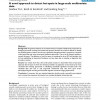Free Online Productivity Tools
i2Speak
i2Symbol
i2OCR
iTex2Img
iWeb2Print
iWeb2Shot
i2Type
iPdf2Split
iPdf2Merge
i2Bopomofo
i2Arabic
i2Style
i2Image
i2PDF
iLatex2Rtf
Sci2ools
115
Voted
BMCBI
2007
2007
A novel approach to detect hot-spots in large-scale multivariate data
Background: Progressive advances in the measurement of complex multifactorial components of biological processes involving both spatial and temporal domains have made it difficult to identify the variables (genes, proteins, neurons etc.) significantly changed activities in response to a stimulus within large data sets using conventional statistical approaches. The set of all changed variables is termed hot-spots. The detection of such hot spots is considered to be an NP hard problem, but by first establishing its theoretical foundation we have been able to develop an algorithm that provides a solution. Results: Our results show that a first-order phase transition is observable whose critical point separates the hot-spot set from the remaining variables. Its application is also found to be more successful than existing approaches in identifying statistically significant hot-spots both with simulated data sets and in real large-scale multivariate data sets from gene arrays, electrophysi...
BMCBI 2007 | Complex Multifactorial Components | Conventional Statistical Approaches | Multivariate Data |
Related Content
| Added | 12 Dec 2010 |
| Updated | 12 Dec 2010 |
| Type | Journal |
| Year | 2007 |
| Where | BMCBI |
| Authors | Jianhua Wu, Keith M. Kendrick, Jianfeng Feng |
Comments (0)

